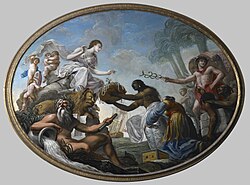East India Company
The East India Company (EIC) was a British joint-stock company that had its headquarters in London. It was started for trading with the East Indies, but most trade was with India and China. It was given a royal charter (official permission) to exist, in 1600 and traded many things in India.
In the mid-18th century, the company built up its own presidency armies and won the Battle of Plassey, which brought it from only trading with India to actually ruling the Indian subcontinent.
The company had armed forces and armed ships. It fought against various Indian rulers and struggled against the Dutch East India Company and other European powers. It was ruled by one governor and 24 directors and became a monopoly in most parts of India.[1]
After the Indian Rebellion of 1857 the British government ruled India directly, and the company was dissolved in 1874.[2] Its role was taken over by the British Raj, which was the Indian gvernment. At its height, the Raj covered a huge area from Baluchistan in the west to Burma in the east, as well as Ceylon and a number of other islands.
East India Company Media
James Lancaster commanded the first East India Company voyage in 1601
Red Dragon fought the Portuguese at the Battle of Swally in 1612, and made several voyages to the East Indies
A document with the original vermilion seal of Tokugawa Ieyasu, granting trade privileges in Japan to the East India Company in 1613
The East Offering its Riches to Britannia - Roma Spiridone, 1778 - BL Foster 245
An engraving of East India House, in Leadenhall Street in the City of London (1766)
The expanded East India House, London, painted by Thomas Malton, c. 1800
Addiscombe Seminary, photographed in c. 1859, with cadets in the foreground
References
- ↑ Chaudhury S. 1999. Merchants, companies, and trade: Europe and Asia in the early modern era. London: Cambridge University Press.
- ↑ Gardner, Brian 1972. The East India Company: a history. McCall Publishing Company. ISBN 0-8415-0124-6








